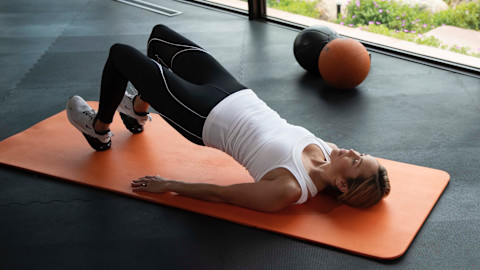How To Actually Reduce Your Chances Of Lower Back Pain, According To A D.C.

How's your back feeling right now?
According to some estimates, up to 80% of people will experience back pain at some point in their lives. Worldwide, it's the single leading cause of disability, making work and normal everyday activities tough at best and impossible at worst. And it's not just folks over a certain age who should be aware of it.
The way you're sitting at this moment—whether hunched over your phone or laptop screen or straight up in an ergonomic position—is actively affecting your posture, which in turn directly affects the short- and long-term health of your spine, for better or worse.
Jeremy James, D.C., CSCS, a specialist in chronic back pain who's worked with Olympic athletes, explains it like this: "Every movement has the potential to be done in a spine-healthy way or a spine unhealthy way. Picking up your kids, getting out of the car, unloading the dishwasher, tying your shoes—if you do them a couple hundred, thousand times in the wrong way, eventually your body breaks down." But until an issue arises, he adds, you might never even feel pain.
The vast majority of conditions that cause back pain are almost always a function of your lifestyle.
If there's one thing James wants people to realize, it's that "back pain isn't a random disease that attacks you. The vast majority of conditions that cause back pain are almost always a function of your lifestyle," compounded over time.
The "young person's back problem."
This isn't to say that mindfully moving in spine-healthy ways is all about preventing back pain years and years down the line. People in their 30s have commonly complained to James about low back pain—the biggest causes are disc-related, from bulges to herniations.
For context, think of spinal discs as jelly-filled doughnuts: When they're healthy, they have a fibrous outer layer and contain liquid inside (which we lose as we age). But certain behaviors can stress discs and, over time, the outer part can wear down and tear, causing a bulging disc or herniation (also called a rupture), when the liquid spills out.
"The majority of people I see in this age group, especially in women who have just given birth, experience bulging and ruptured discs," says James. "It's a young person's problem since their discs are 'healthy' and filled with liquid."

How's the health and strength of your spine?
Anyone curious to know the current state of their spine and how it stacks up health- and strength-wise can take a self-assessment on BackForever, the video-based platform James created to make his clinical programs widely available. While the site's customized content helps people find relief from chronic or debilitating back pain, the BackForever team has seen an influx of 30-somethings taking advantage of the exercise routines and therapeutic instruction.
The basic concepts of spine-healthy movement.
To treat low back pain, a combination of strength training, flexibility training, and aerobic exercise is likely the most effective method, according to research2, and these D.C.-created and approved routines are available on BackForever. In the program, "we teach you a few simple concepts that apply to any movement, situation, or activity and sport you can think of, plus some basic exercises to build up tone and support for your spine," says James. "All are simple bodyweight exercises you can do at home."
For back pain prevention no matter how strong or fit you feel right now, James suggests keeping these two things in mind:
1. Adopt changes to the way you move and carry yourself. "One of the first things I have to teach people is how to use their glutes when they move," says James. "There's a term called gluteal amnesia: When you sit on your butt all day, you lose tone in the muscles, and your brain loses connection neurologically with those muscles. You end up doing movements, like getting out of your chair, with only part of the muscles that you're supposed to engage, for instance, when you put your hands on your thighs to get out of the chair." Learning how to move while keeping your spine neutral is another big one: If you're bending forward, hinge at your hips instead of rounding your back.
2. Build up a base level of strength and tone in the muscles that support your spine. "Balance in the muscles of the core is just as important as strength. We like to work on our abdominals—the front of the core—to the neglect of the lateral and back of the core," says James. "Studies show that that's worse than being overall weak because it places a significant amount of stress on specific parts of the spine. Think of it as a bicycle wheel: If only some of the spokes had tension on them, eventually the wheel would collapse. You have to have equal support on all sides in order to prevent long-term damage." With core exercises, work the sides of your core, your back, and the abdominal wall in spine-healthy ways to achieve balance.
Actively working on these things—how you move, plus the strength and stability of your core—can go a long way in helping you avoid back pain and problems later on. Adulting already gives us enough to worry about as it is.
